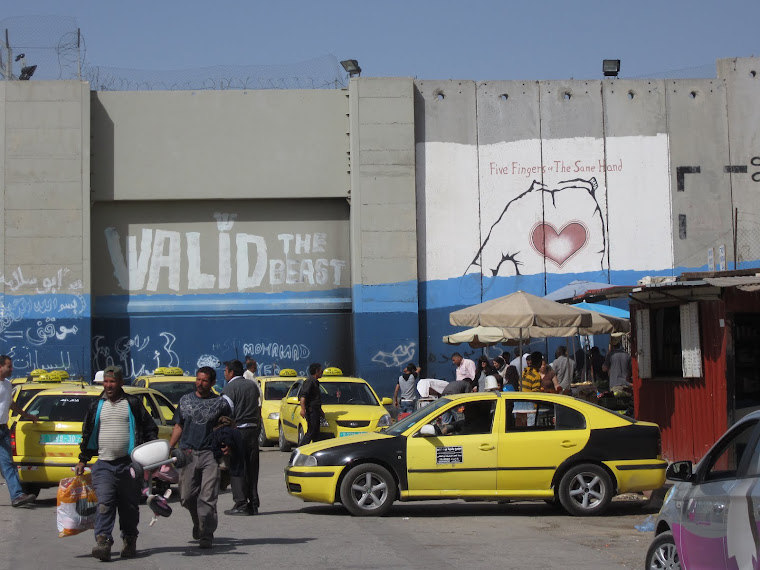All of the land in the Occupied Territories has been designated to be either A, B, or C. Area A is under complete Palestinian control with its own police and governance. West Jerusalem is largely area A as is the center of Bethlehem. A building permit can be applied for to the local Palestinian officials and is normally approved as long the property line is not expanded.There is no presence of Israeli soldiers except for the checkpoints. Life is calmer in area A. Israelis cannot go into Area A. They do come however at great personal risk.
Area C is land that has been designated to be State Land or necessary for the military. If you are a Palestinian living in Area C your property is subject to demolition or seizure. A resident of Area C may not apply for a permit to improve, add to, build a new structure, or go on their roof for any reason at all. Most of the land in Palestine is Area C. In these areas the roads are virtually impossible to drive on, and cannot be improved. In these areas Israelis drive on roads built by Israeli authorities and Palestinian cars are not allowed on these roads. There is no agriculture allowed so those in Area C who have land cannot plant on it. They are virtually refused a livelihood.
Area B is sort if in between. This area is generally near settlements and falls under Israeli governance. This means that there is mostly no police presence, these areas are more dangerous to live in. If you call the police for any reason they will not respond because this area is not controlled by Palestine nor by the Israelis. In area B you may apply to the Israeli Government for a building permit, but not one has been issued. So, you may not repair, add-on, you cant even add a window to a bathroom. Roads cannot be repaired, no additions, no new building at all. If you add anything to your building it will be cited for destruction In both Area B and C, any structure built after 1967 is subject to demolition. ICHAD is an Israeli org that rebuilds demolished homes, but with very poor construction. One woman we met had her home demolished. The rubble still sits and next to it is an ICHAD home which they cannot live in because of the mold. Their house is now under demolition orders once more.
I found it a bit humorous that when we were at the boys secondary school the Head Master, the English teacher, and a staff member were arguing about whether the school was in B or C. They knew it wasn't in A because a donor had given enough money for a new school, but the Israelis refused to give the permit. These boundaries are forever changing and they are never certain. Under the Oslo Accords the areas designated B were supposed to have been turned over to Palestinian governance. What we are seeing is the opposite--that more of area B is being designated C in order to protect the settlers.
Then there are exceptions. There is a village called An Nu'man that resides in the new Israeli definition on Jerusalem. The village is virtually surrounded by settlements and the main access road is an Israeli road. We had traveled to this village for about 30 minutes, where the taxi let us off at the checkpoint and then we had to walk the rest of the way to the village--a long uphill walk. On this, my second visit, we were picked up by Efrat, an Israeli woman with a PhD in anthropology who has written several books about the socio-economic issues surrounding the occupation. We met Efrat on the Israeli side of the checkpoint and she drove on the beautifully groomed and paved roads and we were in An Nu'man in about 10 minutes. As she has Israeli plates we zoomed by the checkpoints. The soldiers were searching trunks of other vehicles, but were not concerned about us. This village is not in A, B, or C but resides in the municipality of Jerusalem. however, in order to enter the village your name must be on the list, you must be a foreigner, or you can be an Israeli. The residents of An Nu'man have not been given Israeli or Jerusalem ID because in the original census of 1967 they were told that as their mufta lived in another village they would be registered there. So, officially no one lives in this village. As no one may enter without being on the list,the population cannot grow and eventually will die or be forced to move out. The 89 school aged children have to go through a checkpoint on their way to school and home. From the age of 5 they are carrying their original birth certificate.
You and I may have difficulty understanding why the villagers would remain under such circumstances. Yusef was born in this village, his father and grandfather also. He has a lovely home and 6 beautiful children. While his English is poor he stated clearly, "The village lives inside us; we do not live in the village."

No comments:
Post a Comment